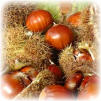Chestnuts (Castania fagaceae):
Part of the human diet for at least 6,000 years, European ("sweet") chestnuts were beloved by Romans, who distributed them far and wide, even into England and Germany. In fact, it was Goethe, author of Faust, who declared in his Prose Maxims, "Let us be many-sided! Turnips are good, but they are best mixed with chestnuts. And these two noble products of the earth grow far apart."
This European species was introduced to America by the French aristocratic family of Dupon Nemours, who emigrated to the East Coast before the French Revolution. It was this species that Thomas Jefferson ultimately grafted onto Virginia root stock.
 "When chestnuts were ripe, I laid up half a bushel for winter."
"When chestnuts were ripe, I laid up half a bushel for winter."
--Henry David Thoreau, Walden
It is precisely because the chestnut, in its great antiquity, is native to Mediterranean Europe, America, and Central Asia/China that there is some hope for American chestnuts recovering from the chestnut blight that struck them early in the 20th century--and that virtually decimated the native population.
Native Americans on the Eastern seaboard relished the American chestnut--consider the Iroquois myth "Hodadenon and the Chestnut Tree," where a small boy foolishly destroys his uncle's last supply of dried chestnuts, ensuring the uncle's death unless he can release the spell cast on the only existing chestnut grove by 7 evil witches. Hodadenon breaks the spell over the grove's enslaved guardians--panthers, bears, and rattlesnakes--and suddenly the dead rise to life and the earth is fruitful once more. He declares chestnuts sacred...and to be shared with everyone forever.

